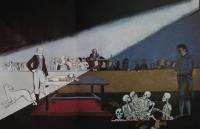Radio ear Blighted nation
Published in 18th-19th Century Social Perspectives, 18th–19th - Century History, General, Issue 2 (March/April 2013), Reviews, The Famine, Volume 21
Robert Ballagh’s stained glass window, An Gorta Mór (2012), commissioned for Ireland’s Great Hunger Museum at Quinnipiac University, Connecticut (see Museum Eye, pp 52–3).
The Great Famine of the 1840s has recently returned to the public eye, with the publication of new histories by Tim Pat Coogan, Enda Delaney and John Kelly, along with the mammoth Atlas of the Great Irish Famine (reviewed on pp 56–7). RTÉ joined in at the start of the year with Blighted nation, a four-part radio series presented by Myles Dungan. Four hours (spread over consecutive nights) is an impressive amount of time to devote to an intensely emotive topic, but the time was used well, and often with considerable imagination.
The impact of the Famine is easily illustrated by its stark, mind-boggling statistics. The Irish population dropped from 8.125 million in 1841 to 6.6 million in 1851. Within that, a death toll of c. 1,000,000 from disease and starvation is hardly unrealistic. The census figures are likely to have been underestimates. When one factors in a collapse in the birth rate of 300,000–400,000 as the population stopped growing, along with mass emigration, by 1851 the Irish population was perhaps 2,000,000 lower than it should have been: a demographic impact that has never been reversed—and probably never will. In 1845 2.4 million acres were devoted to growing potatoes in Ireland; by 1847, thanks to the ravages of Phtophtera infestens, that acreage had collapsed to 284,000. The realities behind such figures make the Famine the seminal event in modern Irish history.
![Distribution of upper-bound estimates of annual excess death rates per county (after Joel Mokyr). When one factors in a collapse in the birth rate of 300,000–400,000 as the population stopped growing, along with mass emigration, by 1851 the Irish population was perhaps two million lower than it should have been. (Atlas of the Great Irish Famine, p.171 [‘Big Book’, pp 56–7])](/wp-content/uploads/2013/03/Radio-ear-Blighted-nation-2.jpg)
Distribution of upper-bound estimates of annual excess death rates per county (after Joel Mokyr). When one factors in a collapse in the birth rate of 300,000–400,000 as the population stopped growing, along with mass emigration, by 1851 the Irish population was perhaps two million lower than it should have been. (Atlas of the Great Irish Famine, p.171 [‘Big Book’, pp 56–7])
Underpinning virtually all commentary and scholarship on the Famine is the lurking question of responsibility. Ireland was, after all, part of the United Kingdom. How could the Famine have been allowed to happen by the UK’s government? Why did they not do more to alleviate it? Or was the Famine precisely what they wanted to see happen? In other words, a ‘genocide’? An attempt to answer this perennial question easily accounted for the liveliest section of the entire series, as Tim Pat Coogan, Mary Daly, Peter Gray and John Kelly argued the toss. Did the British embark on genocide in the Ireland of the 1840s? No; as Kelly pointed out to Coogan, even the limited provision of relief was inconsistent with a desire to wipe out the Irish. That said, however, the callousness and racism of some elements of British officialdom is no myth. The much vaunted laissez-faire stance was perhaps less of a killer than a rigidly ideological insistence on Irish self-sufficiency, and a grotesque willingness to tolerate human suffering as a necessary evil.

Michael Farrell’s Black ’47 (Large) (1997–8), in which the assistant secretary to Her Majesty’s Treasury, Sir Charles Trevelyan, stands trial for non-intervention before a solemn jury of the dead. The second episode of Blighted nation dwelt on the thorny question of responsibility. (Ireland’s Great Hunger Museum, Quinnipiac)
One has to call a spade a spade sometimes. Perhaps, when trying to make sense of such things, we could do without ideologically motivated equivocation. Reaching a conclusion that corresponds to what an Irish nationalist might allegedly believe does not automatically make one an Irish nationalist. The Famine, and the question of whether or not it was genocide, naturally resonates in Irish-America: hence the forthcoming Irish Famine Tribunal, to be hosted by Fordham University in New York in an attempt to weigh the evidence. But those who would respond to this with a lazy stereotype of Irish-America would do well to listen to the segment on how the Famine has been included on New York’s human rights curriculum for high school students aged 9–17. Based on contemporary documents and located in a comparative perspective, it is examined in a nuanced manner that some Irish people might learn from.
Blighted nation also had the guts to look at the vexing long-term impact of the traumatic 1840s. Did helplessness and shame become transformed into distinct Irish cultural traits, with further manifestations such as alcoholism and lingering mental health issues? The burgeoning field of epigenetics makes this possibility worth considering, though it remains awkward territory, given its intensely subjective nature (and an unavoidable weakness of Blighted nation was that the voices of Famine survivors were largely absent). But there were more obvious long-term implications: the loss of the Irish language, mass emigration, radical social and religious change, and even the Gaelic revival of the late nineteenth century: would the latter have happened in the same way without the collapse in the use of Irish? Suffice it to say that modern Ireland began in the 1840s.
Blighted nation was a most impressive documentary series. Perhaps it was a little long, but its engaging mix of reportage and debate ensured that the four episodes easily served as both introduction and overview of the Great Famine. It is to be hoped that RTÉ choose another topic with which to repeat this exercise.
Blighted Nation can be streamed or downloaded as a podcast at http://www.rte.ie/radio1/blightednation/. HI
















